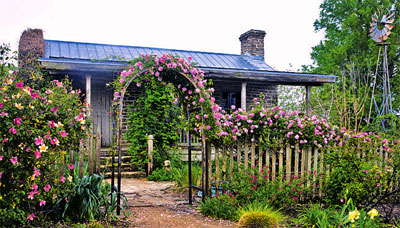Rose Cuttings: August 2014

‘Old Blush’ trained on a fence and trellis becomes the centerpiece of this cottage garden. Photo courtesy of Mike Shoup.
by Mike Shoup
Vertical Structures
Fall is the best time to plant roses. Consider building one of many types of structures now to support a new climbing rose. Vertical training of roses always creates interest in a garden.
Fences: Ugly chain link, chicken wire and barbed wire fences beg to be covered with climbing roses. Split rail, picket and ornamental fences can be accented with shrubs or mannerly climbers.
Arches: Connecting garden rooms or defining entrances, arbors cover walkways from one side to the other, providing clear passage underneath. Roses can be trained from one or both sides; total overhead coverage creates the most dramatic presentation.
Pillars: Roses can be trained vertically around posts of varying heights. A mailbox perched on a 4-foot-tall post creates a small pillar. Six- to 8-foot cedar posts in a border will also support roses. Use chains or rope to connect pillars for a festooned effect with draping roses. Rose canes can be trained in criss-cross fashion, vertically up the sides, or wrapped around posts; the more you manipulate canes, the more blooms they usually yield.
Tripods: Tripods are pillars with three posts positioned several feet apart at the base and tied together at the top. Plant roses in the middle, and train them up all three sides. Or place one thornless climber like ‘Lady Banks’ or ‘Zephirine Drouhin’ on each post to create a hollow bower or cave as a play space.
Pergolas: A series of interconnected arches covering a walkway or patio, a pergola can be used as an allée leading to a feature like a seated area or a sculpture. The walkway can be brick, stone or even grass. Plant just one variety of rose along the sides and allow it to cover the pergola to give the structure a sense of continuity.
Trellises: Form screens or create large, colorful, single-planed displays with trellises. They provide privacy from neighbors along the driveway or between houses as well as hide unsightly air conditioners, television discs and garbage cans. They’re also useful as barriers or dividers, defining the space between a swimming pool and a patio, for example. Note that trellises can require rigorous upkeep as landscape features.

